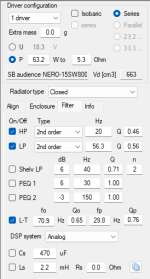I don't have any class A amps but if it is worth getting one, I will try that too..
Not saying class A is needed, but many of the old/simplistic amps with few actives and less loop gain tend to sound less forward/in your face IMHO. The JLH is a simple and cheap DIY amp if you use some laptop bricks to feed it, that's why I used it as an example. Class B should be fine, but there are many amps to chose from, and not all sound the same.
Many like tube amps even if the measured distortion is inferior to almost everything else. I think they usually have low loop gain too.
Maybe you could borrow some amps just to try if you notice an improvement?
Keep up the good work!
GGNTKT calls this a four way. Does that mean the Kii Three is a four way too? This looks like a non-compact Kii Three to me, unless you consider compactness by how far you sit off the front wall. In which case it is more compact than a Kii Three. Anyway, I thought this might be interesting to @vineethkumar01 because he's considering making a huge cardioid design - I assume after he butters his wife up with romantic dinners, beautiful dresses, and fine jewelry.
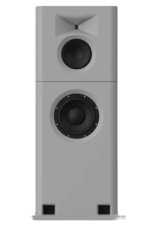
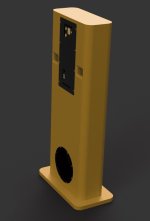
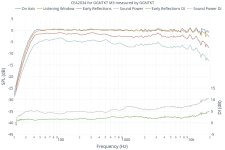
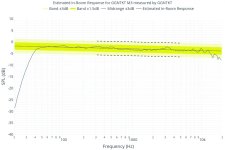
4-way floorstanding speaker, 1-inch compression driver, 8-inch bass-midrange driver and 2x 10-inch subwoofer
Integrated 2-way bass reflex subwoofer front/rear with cardioid dispersion
Shallow waveguide with 140 x 100° radiation pattern, constant directivity from 35 Hz (cardioid mode)
maxSPL 125 dB, Latenz <8 ms, Bass ab 25 Hz @-6 dB, THD <0,1 % (150 – 1500 Hz @90 dB), phasenlinear >80 Hz
Resonance- and noiseless bass reflex ports
All electronics fully integrated into the housing, encapsulated and passively cooled
Two amplifier configurations available with 1000 W (M3) and 1500 W (M3 S)
Dimensions 1286 x 499 x 199 mm (50.6 x 19.6 x 7.8 inches)
GGNTKT's explanation of 4-way




4-way floorstanding speaker, 1-inch compression driver, 8-inch bass-midrange driver and 2x 10-inch subwoofer
Integrated 2-way bass reflex subwoofer front/rear with cardioid dispersion
Shallow waveguide with 140 x 100° radiation pattern, constant directivity from 35 Hz (cardioid mode)
maxSPL 125 dB, Latenz <8 ms, Bass ab 25 Hz @-6 dB, THD <0,1 % (150 – 1500 Hz @90 dB), phasenlinear >80 Hz
Resonance- and noiseless bass reflex ports
All electronics fully integrated into the housing, encapsulated and passively cooled
Two amplifier configurations available with 1000 W (M3) and 1500 W (M3 S)
Dimensions 1286 x 499 x 199 mm (50.6 x 19.6 x 7.8 inches)
GGNTKT's explanation of 4-way
Why four ways?
The division into more than three ways became necessary because the integrated subwoofer unit was realised as a self-sufficient 2-way system and therefore the midrange was designed separately. This was the only way to simultaneously meet the quantitative (level) and qualitative (midrange) requirements we had set ourselves.
Multi-way subwoofer
From 200 Hz downwards, two 10-inch long-throw subwoofers take over, which are controlled completely separately via FIR filtering. This way, different cardioid dispersion variants can be created in the bass range. At the start, a tuning with rear sound cancellation at 180°, i.e. with the zero (null) exactly behind the speaker, will be available. Full effectiveness and thus constant dispersion is achieved from 35 Hz.
Interesting-the power response and early reflections all closely mimic the flat on axis response.
Vineeth; use a pair of ultra shallow subwoofers; reduce the cabinet depth to 10cm of less, and it will suit flat screen TVs quite well. And can pushed right up to the way. The spouses and interior decorators will love this speaker.
Vineeth; use a pair of ultra shallow subwoofers; reduce the cabinet depth to 10cm of less, and it will suit flat screen TVs quite well. And can pushed right up to the way. The spouses and interior decorators will love this speaker.
Last edited:
That GGNTKT looks very good in general, but the rise at ~3,2kHz in all target curves starts to sounds sharp in my ears just from looking at it...
^^^
Agreed.
Would be trivial to shelve that a bit and do listening comparisons to see what was preferable.
Agreed.
Would be trivial to shelve that a bit and do listening comparisons to see what was preferable.
Thanks for pointing out the GGNTKT design.. 🙂 I had this speaker on my radar since last year..GGNTKT calls this a four way. Does that mean the Kii Three is a four way too? This looks like a non-compact Kii Three to me, unless you consider compactness by how far you sit off the front wall. In which case it is more compact than a Kii Three. Anyway, I thought this might be interesting to @vineethkumar01 because he's considering making a huge cardioid design -
https://www.diyaudio.com/community/threads/a-3-way-design-study.376620/post-7181400
And I keep following its developments over at the ASR forum. I think an active cardioid speaker like the GGNTKT is one of the easier ways to design a customizable, pattern-controllable loudspeaker.. 🙂 I guess the most difficult part would be to get that 140 degree beamwidth waveguide design right.
For the woofer-mid part, as an example I just fired up VituixCAD, took two 10inch drivers, put them on a 50cm wide baffle 1m tall, rotated one driver by 180degrees (supposedly placed at the back of the cabinet) with about 250mm depth and was able to get plots like this:
Just playing around with the filter order on the back driver, its attenuation and delay, yields nice patterns ranging from cardioid to super/hyper cardioid. 😀
I think @tmuikku has presented a lot of sims like this in the past in different threads in this forum.
I hope it was as easy as that.. 🤣🤣I assume after he butters his wife up with romantic dinners, beautiful dresses, and fine jewelry.
She has a PhD in the same technical area as me, is much smarter than I am and is into building ML/AI for wireless systems.. So that doesn't help with the buttering up for the speaker-building cause.. 😀
The only way to get things done is to speak the truth, straight and simple. I say I am going to build a speaker like this. It will have these dimensions and will look like this (pointing at the screen to a CAD diagram). Is it ok or not.. 😀 😀
At the moment, she has told me to get rid of my driver stash before buying anymore drivers..
So that is why I am trying to use the Faital pro 15PR400 woofers that I have with yet another passive cardioid box.
The hope was to eventually get multiple subs in the future and spatially spread them out for the below 100Hz range and have the 15PR400 box + EXAR 400 for handling the frequencies above
View attachment 1238456View attachment 1238460View attachment 1238457View attachment 1238458
4-way floorstanding speaker, 1-inch compression driver, 8-inch bass-midrange driver and 2x 10-inch subwoofer
Integrated 2-way bass reflex subwoofer front/rear with cardioid dispersion
Shallow waveguide with 140 x 100° radiation pattern, constant directivity from 35 Hz (cardioid mode)
maxSPL 125 dB, Latenz <8 ms, Bass ab 25 Hz @-6 dB, THD <0,1 % (150 – 1500 Hz @90 dB), phasenlinear >80 Hz
Resonance- and noiseless bass reflex ports
All electronics fully integrated into the housing, encapsulated and passively cooled
Two amplifier configurations available with 1000 W (M3) and 1500 W (M3 S)
Dimensions 1286 x 499 x 199 mm (50.6 x 19.6 x 7.8 inches)
Somehow, these days the looks of the above kind of monolithic design have become a more common sight to the eyes, I think. I find the pattern control & max SPL capabilities of the above speakers to be really impressive, but the looks not as much.. I know looks are not what detrmine how speakers function, but still... 🙂
I do get inspired (by the looks) of speakers like below 🙂 (The MEH technology is the next fascination for me.. 😀)
https://www.aforara.com/collection/b-2
and these
The above speakers having a MEH are much more complicated than my designs. But they did influence the looks of the below design 🙂
I think that sticking to passive cardioid (with the 15PR400 that is probably not suited to open baffle/cardioid kind of loading due to low Qts) + a waveguide that has narrow beamwidth than the GGNTKT is going to affect the sound, in room, significantly. It is also going to make it a difficult task to get pattern control right/as good as the active setup. So I am still unsure of which direction to go with this.
However, since I have anyway got the EXAR 400 printed, first step will be to get them home, listen to them and then decide on the final direction to take...
IIRC @cowanaudio is responsible for these:

And then I hear retailers say that their established / repeat customers want to buy passive speakers, to mix and match (play with) their various amps, sources, interconnects and and cables.
Only the true audio nerds and sound professionals use a touchscreen based PEQ
Eg. https://www.soundcraft.com/en/products/visi-remote
And then I hear retailers say that their established / repeat customers want to buy passive speakers, to mix and match (play with) their various amps, sources, interconnects and and cables.
Only the true audio nerds and sound professionals use a touchscreen based PEQ
Eg. https://www.soundcraft.com/en/products/visi-remote
Last edited:
If you have reasonably low distortion amplifier, you could experiment adding 2nd and maybe 3rd harmonic with software and listen if there is any merit to it. If not, then perhaps it's something else with tube or class a amplifier, that contributes to "better" sound.I don't have any class A amps but if it is worth getting one, I will try that too..
Here is nice thread about some details, considering harmonic distortion. https://www.audiosciencereview.com/...ion-of-low-order-nonlinear-distortions.34863/
I can only wish we had the knowledge and measurement kit then (40+ years ago). We could easily hear differences between brands of tubes, based on f.i. coating on cathode or the physical size of the anode plates.
We could not make measurements to correlate.
L'audiophile with guys like Jean Hiraga did have access to measurement kit, and if i remember correcly possible correlation was more in the higher than 3th harmonics region.
We could not make measurements to correlate.
L'audiophile with guys like Jean Hiraga did have access to measurement kit, and if i remember correcly possible correlation was more in the higher than 3th harmonics region.
you could experiment adding 2nd and maybe 3rd harmonic with software and listen if there is any merit to it.
Been there, done that. It just isn't the same as playing with different amplifiers i.m.h.o. Such a plugin will quickly mess with detail retrieval while with an amp it can be subtle and still have an audible effect.
Even though I did not test any valve amplifiers, in a test with 5 different amplifiers we once did at my place (not blind, but we did balance SPL output) we could hear differences in character from amps with differing topology. A flawed test, I know, but after all I read up till then I expected to not being able to hear any differences.
It's the reason I eventually went with mosfet amplifiers because I was attracted to their particular midrange sound. I am told it is the distortion profile that's key to these features, H2 well above H3 etc and much lower values of H5 and up. Reading up on it I came across several posts by Aksa (Hugh) that referred to the fact that it is this distortion profile (while actual distortion being much lower than for most valve amps) that is responsible for its sweet and rich sound. Very seductive sound on vocals is what struck me.
This post being anecdotal and not scientific, I haven't found any obvious clues in measurements to back-up my claims. Distortion still is low overall.
As measured at the listening spot. Obvious to see that H2 is dominant for both speaker system + amplifier.
I am interested in ultra shallow subwoofers.. 😀Interesting-the power response and early reflections all closely mimic the flat on axis response.
Vineeth; use a pair of ultra shallow subwoofers; reduce the cabinet depth to 10cm of less, and it will suit flat screen TVs quite well. And can pushed right up to the way. The spouses and interior decorators will love this speaker.
What all such subwoofers are available in the market these days. I know of only these:
https://sbacoustics.com/product-category/drivers/shallow-subwoofers/
There is an SB acoustics one which looks ok.
Not ultra shallow but not so deep either.. Models nicely in a 25L box as well with some EQ


Not ultra shallow but not so deep either.. Models nicely in a 25L box as well with some EQ
https://www.madisoundspeakerstore.com/subwoofers/neotera-audio-10-ultra-flat-subwoofer-4-ohm/
Here's a weird one I saw few months ago.
Here's a weird one I saw few months ago.
Very interesting... EBP 9.2 😀 Nice non-linearities, but does the heavy underdamping affect sound?https://www.madisoundspeakerstore.com/subwoofers/neotera-audio-10-ultra-flat-subwoofer-4-ohm/
Here's a weird one I saw few months ago.
Just studying the performance envelope of different sub drivers.
Here is a locally available SB 15inch sub driver:
https://www.sbaudience.com/index.php/products/subwoofers/nero-15sw800/
Driver alone weighs about 16.3kg 😀
Modeled in a 35litre box, it looks like it can do this with some DSP-based response shaping.
It looks like it wants to eat power for breakfast, lunch, and dinner 😀

f3 29.1 Hz
f6 23.8 Hz
f10 19.4 Hz
Zmin 5.7 Ohm @ 5 Hz
Zmax 46.2 Ohm @ 63.5 Hz
GDmax 26 ms @ 6.1 Hz
XmaxC 7.4 mm @ 24.1 Hz
Pmax 288.5 VA @ 23.4 Hz
-------------------------------------------------------------
DRIVER: SB audience NERO-15SW800 Subwoofer, 1 pcs in series
n0 1.07 % Reference efficiency
SPL 92.4 dB/W Sensitivity
USPL 94.2 dB/2.83 Sensitivity
EBP 86.3 Efficiency bandwidth product
Dd 33.1 cm Effective diameter of driver
Vd 662.6 cm^3 Maximum linear volume of displacement
Cas 9.69E-7 m^5/N Acoustic equivalent of Cms
Mas 2.8E1 kg/m^4 Acoustic equivalent of Mms+Mme
Ras 7.09E2 Ns/m^5 Acoustic equivalent of Rms
Rae 1.52E4 Ns/m^5 Acoustic equivalent of Re
-------------------------------------------------------------
BOX REAR 1: Vb=40.5 l, Ql=100.0
Fb 64.0 Hz System resonance frequency
Cab 2.86E-7 m^5/N Acoustic compliance of air in enclosure
Rab 1.24E3 Ns/m^5 Acoustic resistance due to absorption
Ral 8.68E5 Ns/m^5 Acoustic resistance due to leakage
Qtc 0.64 Total Q factor

Here is a locally available SB 15inch sub driver:
https://www.sbaudience.com/index.php/products/subwoofers/nero-15sw800/
Driver alone weighs about 16.3kg 😀
Modeled in a 35litre box, it looks like it can do this with some DSP-based response shaping.
It looks like it wants to eat power for breakfast, lunch, and dinner 😀
f3 29.1 Hz
f6 23.8 Hz
f10 19.4 Hz
Zmin 5.7 Ohm @ 5 Hz
Zmax 46.2 Ohm @ 63.5 Hz
GDmax 26 ms @ 6.1 Hz
XmaxC 7.4 mm @ 24.1 Hz
Pmax 288.5 VA @ 23.4 Hz
-------------------------------------------------------------
DRIVER: SB audience NERO-15SW800 Subwoofer, 1 pcs in series
n0 1.07 % Reference efficiency
SPL 92.4 dB/W Sensitivity
USPL 94.2 dB/2.83 Sensitivity
EBP 86.3 Efficiency bandwidth product
Dd 33.1 cm Effective diameter of driver
Vd 662.6 cm^3 Maximum linear volume of displacement
Cas 9.69E-7 m^5/N Acoustic equivalent of Cms
Mas 2.8E1 kg/m^4 Acoustic equivalent of Mms+Mme
Ras 7.09E2 Ns/m^5 Acoustic equivalent of Rms
Rae 1.52E4 Ns/m^5 Acoustic equivalent of Re
-------------------------------------------------------------
BOX REAR 1: Vb=40.5 l, Ql=100.0
Fb 64.0 Hz System resonance frequency
Cab 2.86E-7 m^5/N Acoustic compliance of air in enclosure
Rab 1.24E3 Ns/m^5 Acoustic resistance due to absorption
Ral 8.68E5 Ns/m^5 Acoustic resistance due to leakage
Qtc 0.64 Total Q factor
Attachments
2 x SB acoustics SW26DBAC76-8 shallow subs in parallel in 30L box
STATISTICS
f3 24.1 Hz
f6 20.9 Hz
f10 17.6 Hz
Zmin 3.2 Ohm @ 39793.9 Hz
Zmax 26.8 Ohm @ 39.4 Hz
GDmax 26.8 ms @ 7.6 Hz
XmaxC 11.2 mm @ 24.1 Hz
Pmax 166.6 VA @ 22.8 Hz
-------------------------------------------------------------
DRIVER: SB acoustics SW26DBAC76-8, 2 pcs in parallel
n0 0.26 % Reference efficiency
SPL 86.3 dB/W Sensitivity
USPL 90.3 dB/2.83 Sensitivity
EBP 66.1 Efficiency bandwidth product
Dd 19.9 cm Effective diameter of driver
Vd 748.8 cm^3 Maximum linear volume of displacement
Cas 7.64E-7 m^5/N Acoustic equivalent of Cms
Mas 8.83E1 kg/m^4 Acoustic equivalent of Mms+Mme
Ras 2.47E3 Ns/m^5 Acoustic equivalent of Rms
Rae 3.68E4 Ns/m^5 Acoustic equivalent of Re
-------------------------------------------------------------
BOX REAR 1: Vb=34.7 l, Ql=100.0
Fb 39.3 Hz System resonance frequency
Cab 2.45E-7 m^5/N Acoustic compliance of air in enclosure
Rab 2.36E3 Ns/m^5 Acoustic resistance due to absorption
Ral 1.65E6 Ns/m^5 Acoustic resistance due to leakage
Qtc 0.52 Total Q factor

f3 24.1 Hz
f6 20.9 Hz
f10 17.6 Hz
Zmin 3.2 Ohm @ 39793.9 Hz
Zmax 26.8 Ohm @ 39.4 Hz
GDmax 26.8 ms @ 7.6 Hz
XmaxC 11.2 mm @ 24.1 Hz
Pmax 166.6 VA @ 22.8 Hz
-------------------------------------------------------------
DRIVER: SB acoustics SW26DBAC76-8, 2 pcs in parallel
n0 0.26 % Reference efficiency
SPL 86.3 dB/W Sensitivity
USPL 90.3 dB/2.83 Sensitivity
EBP 66.1 Efficiency bandwidth product
Dd 19.9 cm Effective diameter of driver
Vd 748.8 cm^3 Maximum linear volume of displacement
Cas 7.64E-7 m^5/N Acoustic equivalent of Cms
Mas 8.83E1 kg/m^4 Acoustic equivalent of Mms+Mme
Ras 2.47E3 Ns/m^5 Acoustic equivalent of Rms
Rae 3.68E4 Ns/m^5 Acoustic equivalent of Re
-------------------------------------------------------------
BOX REAR 1: Vb=34.7 l, Ql=100.0
Fb 39.3 Hz System resonance frequency
Cab 2.45E-7 m^5/N Acoustic compliance of air in enclosure
Rab 2.36E3 Ns/m^5 Acoustic resistance due to absorption
Ral 1.65E6 Ns/m^5 Acoustic resistance due to leakage
Qtc 0.52 Total Q factor
I think I like this 15inch driver 😀
http://www.sbaudience.com/index.php/products/subwoofers/rosso-15sw800/
Models like below this in a 30litre closed box cabinet. I am thinking a 20cm radius cylinder with 25 ish depth.
That is to put it at the back of this cabinet 😀


STATISTICS
f3 28.3 Hz
f6 23.4 Hz
f10 20 Hz
Zmin 5.4 Ohm @ 5 Hz
Zmax 41.6 Ohm @ 84.8 Hz
GDmax 25.8 ms @ 18.3 Hz
XmaxC 4.5 mm @ 25.2 Hz
Pmax 155.9 VA @ 24.5 Hz
-------------------------------------------------------------
DRIVER: SB Audience Rosso-15SW800, 1 pcs in series
n0 1.66 % Reference efficiency
SPL 94.3 dB/W Sensitivity
USPL 96.2 dB/2.83 Sensitivity
EBP 94.8 Efficiency bandwidth product
Dd 32.9 cm Effective diameter of driver
Vd 467.6 cm^3 Maximum linear volume of displacement
Cas 6.5E-7 m^5/N Acoustic equivalent of Cms
Mas 1.99E1 kg/m^4 Acoustic equivalent of Mms+Mme
Ras 5.67E2 Ns/m^5 Acoustic equivalent of Rms
Rae 1.18E4 Ns/m^5 Acoustic equivalent of Re
-------------------------------------------------------------
BOX REAR 1: Vb=34.7 l, Ql=100.0
Fb 84.6 Hz System resonance frequency
Cab 2.45E-7 m^5/N Acoustic compliance of air in enclosure
Rab 1.1E3 Ns/m^5 Acoustic resistance due to absorption
Ral 7.67E5 Ns/m^5 Acoustic resistance due to leakage
Qtc 0.76 Total Q factor

Is this kind of abuse doable with this driver?
What are the disadvantages/hazards of doing this?
http://www.sbaudience.com/index.php/products/subwoofers/rosso-15sw800/
Models like below this in a 30litre closed box cabinet. I am thinking a 20cm radius cylinder with 25 ish depth.
That is to put it at the back of this cabinet 😀
STATISTICS
f3 28.3 Hz
f6 23.4 Hz
f10 20 Hz
Zmin 5.4 Ohm @ 5 Hz
Zmax 41.6 Ohm @ 84.8 Hz
GDmax 25.8 ms @ 18.3 Hz
XmaxC 4.5 mm @ 25.2 Hz
Pmax 155.9 VA @ 24.5 Hz
-------------------------------------------------------------
DRIVER: SB Audience Rosso-15SW800, 1 pcs in series
n0 1.66 % Reference efficiency
SPL 94.3 dB/W Sensitivity
USPL 96.2 dB/2.83 Sensitivity
EBP 94.8 Efficiency bandwidth product
Dd 32.9 cm Effective diameter of driver
Vd 467.6 cm^3 Maximum linear volume of displacement
Cas 6.5E-7 m^5/N Acoustic equivalent of Cms
Mas 1.99E1 kg/m^4 Acoustic equivalent of Mms+Mme
Ras 5.67E2 Ns/m^5 Acoustic equivalent of Rms
Rae 1.18E4 Ns/m^5 Acoustic equivalent of Re
-------------------------------------------------------------
BOX REAR 1: Vb=34.7 l, Ql=100.0
Fb 84.6 Hz System resonance frequency
Cab 2.45E-7 m^5/N Acoustic compliance of air in enclosure
Rab 1.1E3 Ns/m^5 Acoustic resistance due to absorption
Ral 7.67E5 Ns/m^5 Acoustic resistance due to leakage
Qtc 0.76 Total Q factor
Is this kind of abuse doable with this driver?
What are the disadvantages/hazards of doing this?
Maybe it will become a little ugly-looking cabinet if I put the above 15inch subwoofer, one per side, at the back of the cardioid box. 🤔
Now the cabinet depth becomes 45cm fromfront baffle to back compared to the 28cm earlier..


Maybe, I should vertically displace the drivers to see what can be done to reduce the depth of the cabinet.
The cardioid 15inch moving towards the top in the front, the subwoofer 15inch driver at the back near the floor.. and the cabinet depth reduced 🤔
Now the cabinet depth becomes 45cm fromfront baffle to back compared to the 28cm earlier..
Maybe, I should vertically displace the drivers to see what can be done to reduce the depth of the cabinet.
The cardioid 15inch moving towards the top in the front, the subwoofer 15inch driver at the back near the floor.. and the cabinet depth reduced 🤔
Last edited:
- Home
- Loudspeakers
- Multi-Way
- A 3 way design study
